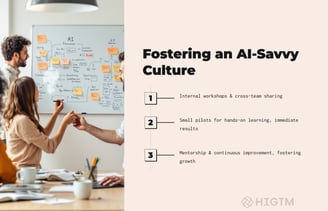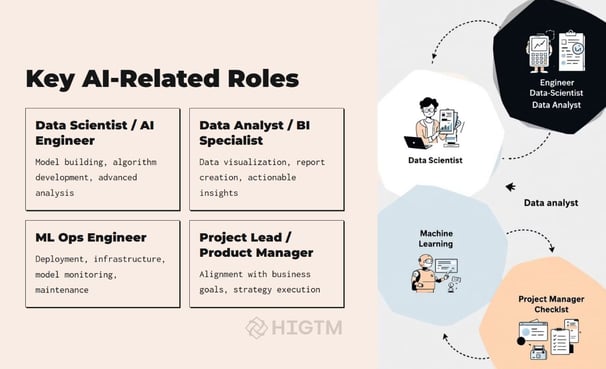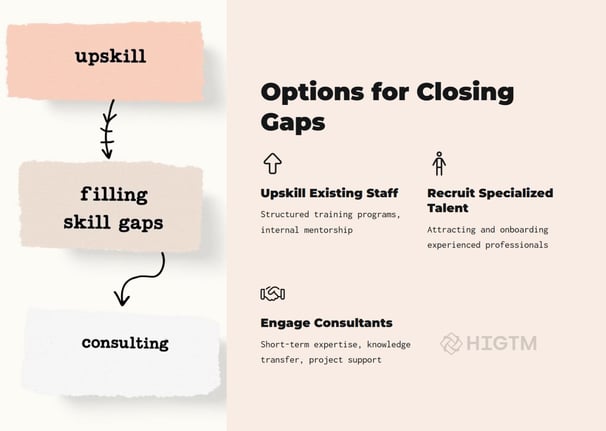29. Talent Needs & Skill Gaps – Intro to AI-Savvy Roles
Artificial Intelligence promises better decision-making, cost savings, and fresh ways to engage customers. Yet many small and medium-sized enterprises lack the specific people needed to plan, implement, and maintain AI-driven solutions. Who are these AI-savvy professionals? What skill gaps often arise? How can a smaller organization fill them without straining budgets? This article delves into the roles crucial for AI success and practical strategies to build or acquire the right expertise.
Q1: FOUNDATIONS OF AI IN SME MANAGEMENT - CHAPTER 1 (DAYS 1–31): CORE AI CONCEPTS & VALUE PROPOSITION
Gary Stoyanov PhD
1/29/20257 min read

1. Why AI Talent Is Crucial for SMEs
AI isn’t an off-the-shelf “plug and play” system. It involves data wrangling, model training, continuous monitoring, and strategic interpretation. Skimping on the right roles leaves AI projects half-implemented or tangled in confusion. The workforce shapes AI’s real-world impact—no matter how sophisticated the software might be.
1.1 Surpassing the Hype
The AI hype cycle can create unrealistic expectations. Skilled individuals manage these expectations, ensuring that each project remains grounded in tangible outcomes rather than tech buzzwords.
1.2 Bridging Tech and Business
Data scientists may understand algorithms, but if no one ties these models to sales, operations, or product design, the insights stay academic. Skilled AI-savvy employees make the connection between bits of code and real business metrics, such as boosted revenue or improved efficiency.
1.3 Ongoing Evolution
AI techniques change rapidly. A team used to older analytics might not keep pace with new libraries or compliance mandates. Adaptable people keep your organization agile in the shifting AI landscape.
2. Core Roles in AI Adoption
2.1 Data Scientist / AI Engineer
These professionals create the “brains” of your AI. They design, train, and fine-tune algorithms, whether it’s a simple regression model for predicting sales or a complex deep neural network for image recognition. Skills often include:
Programming: Python, R, or similar.
Math & Statistics: Linear algebra, probability, optimization.
Domain Knowledge: Understanding your industry’s data points to craft relevant features.
2.2 Data Analyst / Business Intelligence Specialist
Where a data scientist delves into model building, the BI specialist extracts actionable insights from raw data. They produce dashboards, reports, or visualizations that let stakeholders see real-time performance.
SQL & Databases: Efficiently querying data sets.
Visualization Tools: Power BI, Tableau, or similar platforms.
Communication Skills: Translating numbers into stories that prompt action.
2.3 ML Ops Engineer
Machine learning operations (ML ops) revolve around the deployment and upkeep of AI models. It’s the difference between a successful pilot in a test environment and a stable production system for customers or employees.
DevOps Know-How: CI/CD pipelines, containerization with Docker, orchestration with Kubernetes.
Model Version Control: Tracking updates, ensuring consistent performance after each tweak.
Monitoring & Alerts: Checking resource usage, detecting data drifts that reduce accuracy over time.
2.4 Project Lead / Product Manager
The project lead or product manager ensures the AI project addresses actual needs, sets realistic milestones, and organizes cross-department interactions.
Business & Domain Expertise: They know how the product or service works, what customers expect, and where AI can improve processes.
Project Coordination: Scheduling sprints or phases, coordinating tasks among data scientists and IT staff, and balancing scope with deadlines.
Stakeholder Communication: Presenting AI’s progress and results to leadership in a straightforward manner.
3. Common Skill Gaps Within SMEs
3.1 Technical Depth
Some businesses treat AI like advanced analytics, lacking staff who can code or handle machine learning frameworks (e.g., TensorFlow, PyTorch). This gap hinders deeper insights beyond basic reporting.
3.2 Data Governance & Security
Employees might not grasp advanced data handling rules, from encryption to compliance with privacy regulations like GDPR. Lapses here lead to major risk if sensitive data is mismanaged.
3.3 Business Context Integration
An SME might hire a strong data scientist but struggle to connect model outputs to day-to-day decisions. Or the existing managers might ignore AI recommendations because they lack trust or clarity, diminishing the project’s impact.
3.4 No Real “Connector” Role
When no one acts as a mediator among data, code, and overall strategy, AI projects can become siloed. That’s why a product manager or project lead who “speaks tech and business” is often vital.
4. Potential Approaches to Fill Talent Gaps
4.1 Upskill Internal Employees
Workshops & Online Learning: Platforms like Coursera, DataCamp, or specialized local events allow staff to gain relevant skills. For example, a marketing analyst might learn python-based data analysis or a finance person might pick up basic machine learning.
Mentorship Programs: Pair novices with more experienced AI practitioners, even if you only have a single advanced staff member or an external mentor from a consulting firm.
4.2 Hiring Full-Time
When to Hire: If your AI workload is growing quickly, or if you see a permanent need for algorithm updates, data pipeline expansions, or MLOps.
Recruitment Strategy: Emphasize the broader range of tasks. Many skilled data scientists or ML ops engineers enjoy diverse responsibilities, especially at an SME where they can see direct impact.
4.3 Working with Consultants
Short-Term Expertise: Ideal for specialized tasks (like building an advanced recommendation engine) or jump-starting a pilot project.
Knowledge Transfer: Consultants can train in-house teams, ensuring the skill remains after the contract ends. This arrangement helps you avoid hiring a full-time senior professional before your AI initiative matures.
4.4 Hybrid Model
Some SMEs choose a hybrid approach. They hire a single data scientist for daily tasks but bring in consultants for deeper or more advanced challenges. Meanwhile, existing staff pick up additional responsibilities or skills that support small tasks.
5. Culture and Organizational Support
5.1 Cross-Department Engagement
If only the IT department invests in AI, adoption falters. Each department—from finance to marketing—should see how AI can enhance their objectives. This fosters an environment where data is shared openly, and project leads get the support needed for smooth development.
5.2 Visible Leadership Buy-In
Executives who champion AI, show excitement for new models, or communicate early wins spark broader interest. If top leaders treat AI as a side experiment, staff might not commit wholeheartedly.
5.3 Clear Roadmap
Define short-, mid-, and long-term goals. For instance:
Short-Term: Automate an internal reporting workflow.
Mid-Term: Develop a pilot for customer churn prediction.
Long-Term: Deploy advanced personalization or forecasting that scales across multiple product lines.
This clarity helps employees see that AI won’t vanish next quarter, so learning new skills pays off for them too.
6. Real-World Snapshots: Skill Gaps in Action
6.1 E-Commerce Startup
They tried building a recommendation engine but lacked a data scientist. Their software developer attempted it anyway, leading to clumsy code and poor results. Hiring a part-time data scientist fixed the system, giving them a 10% sales lift.
6.2 Manufacturing SME
A small factory introduced sensors to track machine performance but found no one could interpret the data for predictive maintenance. After a short upskilling course for two technicians, the factory identified early warning signs of machine failures, saving thousands in downtime.
6.3 Healthcare Clinic
They brought in advanced analytics to streamline patient scheduling but had no project manager connecting the AI’s recommendations with daily staff routines. Frustrations emerged. Hiring a healthcare-savvy AI coordinator aligned the scheduling tool with real operational constraints.
7. Pitfalls to Avoid
All Tech, No Business Sense: Overly focusing on model accuracy but ignoring domain context.
Unclear Roles & Responsibilities: Data scientists forced to manage deployment or user training can derail synergy.
Forgetting Ethical or Privacy Considerations: Skilled staff ensure compliance with data regulations and maintain user trust.
Prolonged Pilots: Aimless AI proofs-of-concept waste time and morale if no one is in charge of driving them to production.
8. Tomorrow’s AI Roles
8.1 Domain-Specific Roles
More specialized roles keep emerging: a data scientist who’s also an expert in finance, a marketing analyst with advanced text analytics knowledge, or an MLOps engineer specialized in edge computing.
8.2 Data Ethicist
As consumer data grows, so do privacy concerns. Some SMEs may consider a part-time data ethicist or compliance officer who ensures that every AI project respects legal and ethical guidelines.
8.3 Automation & Low-Code Tools
Advances in automation can lighten the technical load. If your business uses low-code or auto-ML platforms, your data analyst might handle tasks once done by a data scientist. Even so, advanced roles remain vital for strategic oversight.
9. Building Your Talent Strategy
9.1 Assess Current Staff
Ask each department to list data or AI-related tasks they handle. Identify where knowledge runs thin. Maybe a marketing specialist wants to learn deeper analytics. Or an IT staffer yearns to expand into MLOps.
9.2 Define Must-Have Roles
If your immediate goal is deploying an anomaly detection system, you might prioritize a data scientist or MLOps engineer. If you need better dashboards, a BI specialist or data analyst might be more urgent.
9.3 Plan a Blended Approach
Combine upskilling for minor tasks with consultants or new hires for advanced work. This approach keeps costs in check while covering any major skill shortage.
9.4 Provide Growth Pathways
Employees often stick with a role if they see continued learning opportunities. For instance, a tech-savvy marketing associate might gradually morph into a data-savvy marketing lead.
10. Practical Checklist
Identify AI Use Cases: Are you focusing on automation, personalization, forecasting, or something else?
Map Roles to Each Use Case: Who will build the model, interpret results, handle deployment, and connect it to real business processes?
Conduct a Skill Inventory: Evaluate staff backgrounds, external networks, and potential training time.
Set Hiring vs. Training Plans: Determine which roles demand immediate recruitment vs. which you can grow internally.
Monitor Progress: Reassess skill gaps every quarter. AI evolves fast, so keep an eye on what new tools or methods might require fresh competencies.






11. Moving Forward
11.1 Start Small with Upskilling
Offer staff short courses or sponsor them to watch relevant online tutorials. Even a day or two of structured instruction can close simpler skill gaps.
11.2 Recruit Wisely
When you do hire, pick people who can wear multiple hats. Many SMEs can’t afford separate data scientists, data engineers, and MLOps specialists. You need flexible individuals who enjoy bridging tasks.
11.3 Partner or Consult
Short-term consulting can bring advanced knowledge to tricky or high-stakes projects, with knowledge transfer to in-house staff as part of the contract.
A well-rounded team underpins every successful AI deployment. Data scientists and MLOps engineers handle algorithms and infrastructure, data analysts transform raw numbers into insights, and project leads link all these efforts to real business goals. If your SME sees skill gaps in any of these areas, you can choose a practical blend of upskilling, hiring, or consultant support.
By nurturing a collaborative culture, focusing on immediate use cases, and continuously re-checking your talent strategy, you’ll build a workforce prepared for tomorrow’s AI challenges.
Let’s bridge the gaps and ensure your SME remains agile, innovative, and ready for the data-driven age.
Turn AI into ROI — Win Faster with HIGTM.
Consult with us to discuss how to manage and grow your business operations with AI.
© 2025 HIGTM. All rights reserved.
